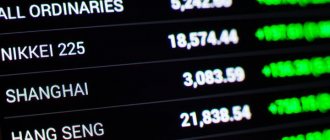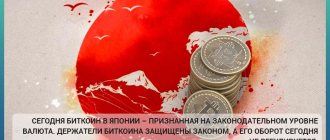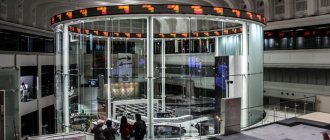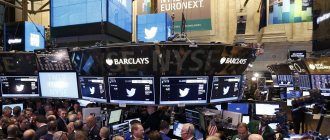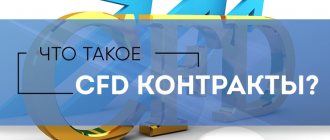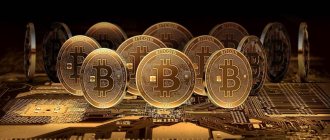No one will take care of your well-being better than you. Unfortunately, the level of financial literacy in our and other countries is really low. Most people live from paycheck to paycheck and don’t think it’s possible to live any other way. It’s time to understand that only you yourself can change this, that you cannot rely on the state, on some “uncle”. You need to take responsibility into your own hands and finally figure out your financial life.
The index investment strategy discussed in this article is the simplest way to increase capital. Although the strategy is passive, it beats hedge funds and active strategy funds on average. Thus, the index strategy is both easy to use and more profitable over a long period of time than other strategies that require active participation.
Necessary theory
It's worth doing a little preparation before learning about index investing. This is especially true for beginners who have recently become acquainted with the stock exchange and came across this article. Advanced readers may want to skip this chapter. Here we will look at the basic theory that you need to know to understand the essence of the index investing strategy and its benefits.
Financial literacy
This topic is too large, so it is included in a separate article, which is entirely devoted to financial literacy.
How does compound interest work?
Compound interest is our main assistant in creating capital. What it is? For example, you lent me 100 rubles for 1 year at 12% per annum. After a year, I return them to you, you receive 112 rubles in your hands. Everything is clear here, this is how simple interest works.
Let's consider another case. You also lent me 100 rubles for 1 year at the same 12% per annum, but I pay you 1% every month. But you won’t receive them in your hands, and they will be added to the principal amount (like capitalization of interest in banks). Thus, in a month you will have 101 rubles, in the second month 102 rubles and 1 kopeck. For the third month, 103 rubles and 3 kopecks and so on. In a year the amount will be 112 rubles and 68 kopecks. Compared to 1 case, the amount turned out to be 68 kopecks more. In this case, the difference is not great, but, nevertheless, it is there. And if you use larger amounts and longer periods of time, the difference will be huge. In mathematics this is called a geometric progression.
If you do not understand the calculation in the paragraph above, then we recommend reading the article about the compound interest formula. Everything is described there in great detail.
Let's see how compound interest works over a longer period using the example of a “deposit” at 18% per annum. This is the percentage the Russian stock market has earned on average over the past 17 years. Three examples of how compound interest works are considered: with a one-time investment, the father’s strategy and the daughter’s strategy.
You may notice that the daughter's strategy is the most effective. The decisive factor here is not the amount of the initial investment or the amount of annual contributions, but the period of investment. The daughter started with only 20,000 rubles and made deductions of 3,000 rubles. However, by the age of 60, her capital exceeded 160 million rubles.
The human brain has little understanding of how compound interest works, so it looks like magic and there is even an expression “the magic of compound interest.” Compound interest allows you to create large amounts of capital and it really is like magic. Especially in the long term.
Stock Market Basics
The stock market is based on exchanges. These are just buildings and some platforms for trading. Unlike other markets, they trade not in things, but in securities. Once upon a time, this all worked physically: people gathered, bought and sold shares from each other. Even in the 20th century, when there were no computers, they worked this way. You might have seen this in some American films, which show noisy halls, where there are a lot of shouts of “I’m buying” or “I’m selling,” constant tension and excitement. Now this is no longer the case; everything works electronically, via the Internet and computers. Thus, the trading process is more streamlined and millions of traders (or traders) can participate in transactions.
An ordinary person cannot buy shares on such exchanges on his own; he needs to turn to an intermediary. These intermediaries are licensed organizations such as brokers or management companies. A license from the Central Bank allows such organizations to operate on the stock exchange. Securities that are bought and sold on the stock exchange are not just records from a broker, they are full-fledged private property protected by the state. A record of the ownership of securities is made to the depository, which ensures the safety of information about how many and what securities you own. This scheme has been working for a long time and is completely legal and protected.
The main securities on stock exchanges are divided into stocks and bonds. This issue is discussed in more detail in the article about the basics of the stock market.
Why should you invest in stocks?
The picture below shows a graph of US market returns over more than 2 centuries.
It is interesting to us because it allows us to clearly see how securities behave over a long period of time. Stocks are shares, Bonds and Bills are bonds, Gold is gold. It also takes into account inflation in the US - this is CPI. The graph has a logarithmic form: with an equal step along the “x” axis, the amount of the asset grows equally proportionally. Each interval increases the value by 10 times. This was done in order to fit various assets on one chart and have a visual representation of asset growth as a percentage.
We see that from 1 dollar the US stock market was able to grow capital to 13 million dollars. At the same time, the bonds rose to only 18 thousand. And gold and inflation remained even lower. We're clearly seeing bonds outperform inflation, and stocks have risen much, much more than bonds. What else does this graph show us? The fact that stocks fluctuated more strongly: at some points they showed a strong fall (the period of the Great Depression in 1930 and the dot-com crisis in 2000), but after a few years the fall was replaced by rapid growth. Overall, the stock market's tilt hasn't changed very much, and over the long term, stocks have grown much faster than other instruments. It is stocks that allow you to create capital faster than anything else. Even if they sometimes become cheaper, history shows us that any fall will certainly be replaced by growth.
Let's now see how Russian assets behaved.
The stock market in Russia is quite young, so we cannot see such a long history as with the US market. The stock market in the chart above represents the MICEX index, as it includes shares of the largest companies. We see on the chart that during the period 2000-2008 the shares grew very well, but then the crisis happened and they fell. The most favorite means of saving money, the euro and the dollar, we see, are greatly inferior even to inflation, despite significant fluctuations in recent years. Gold beats inflation, allows you to save money and increase it a little. The most profitable are stocks and real estate.
If we calculate the return on these assets over 16 years, we will see that the shares showed an increase of 11.7 times and gave 16.7% per annum. Real estate grew 9.7 times, showing a yield of 15.3% per annum. Gold increased 9.5 times with a yield of 15.2% per annum. Inflation increased 5.6 times or 11.4% per annum. When calculating interest, the average annual interest rate was taken.
What is the main disadvantage of indexes?
Buffett's victory over Seids is often cited as the strongest argument in the debate about whether active or passive investing is better. So it is believed that investing in ETFs and mutual funds is always more profitable in the long term than in mutual funds or individual shares. In other words, passive investments in indexes are more profitable than active investments in other instruments.
However, this forgets the most important drawback of indices, due to the specifics of their formation.
The index includes shares of dozens of companies in different proportions. For example, company A occupies 20% of the index, B – 10%, C – also 10%, D, D, E – 7% each, and the other 20 companies occupy the rest of the index. If the shares of company A (which is the most voluminous) fall, then the entire index declines. To maintain the high value of the entire index, the exchange reduces the volume of shares of this company and increases the volume of shares of company B, which at this time grows. That is, formally the index seems to have grown, but the basic rule of investing has not been followed: buy cheaper, sell more expensive.
An ETF that follows the index will be forced to sell cheap shares and buy expensive ones in order to maintain the structure of the index. A smart investor behaves differently: he buys cheap shares and sells expensive ones.
The creators of the index are easy to understand. As a result, the investment result is quite good. After all, ordinary investors who behave irrationally will not invest in a falling market in the hope of winning back their losses “someday.”
But this is similar to manipulation of statistics, when inconvenient information is simply ignored, and the picture ultimately looks more presentable.
However, if you look at the experience of some leading countries, it turns out that such a unique approach to the formation of the index does not always help. Due to incorrect rebalancing, the German Dax index cannot get out of the sideways trend. If you had bought a German index ETF sometime in March 2020, you would now have literally negligible gains. Of course, there are periods of decline and decline on the chart, and you could buy ETF shares on the drawdowns and sell them on the highs, but this no longer looks like passive investing, does it?
The situation with the Swedish OMXS30 index is approximately the same. Look at the chart yourself and analyze.
Or the Japanese Nikkei 225.
No, I'm not saying that indices are not growing. Or that the problem of growth is solely due to improper rebalancing. After all, the structure of the indices is thought out by very educated economists using very sophisticated formulas, and all this is not just like that. The point is different.
If the index had been formed according to the principles of reasonable investment, the result could have been better. Much better. But this would not be accepted by the investor community.
And here’s another interesting article: ETF FXTB: profitability, investment conditions, asset composition
What's better: stocks or real estate?
In Russia, real estate has always grown at a rapid pace and among Russians it has become a favorite way to reliably invest money. What could be simpler? Bought an apartment, or better yet several, and live off the rent. Almost everyone has this desire until you become well acquainted with the stock market.
Indeed, the returns on real estate and stocks are similar, but stocks are a more flexible growth tool and better suited for a private investor. Let's weigh the pros and cons so that there is no doubt left.
| Real estate | Stock |
| Carrying out renovations, buying furniture, finding tenants, solving problems... | Passive investing |
| Large amounts | Small amounts |
| You cannot reinvest the income received, since a new apartment again requires a large amount, and it is difficult to buy a piece of the apartment. | You can immediately reinvest the income received, that is, use the income received to buy shares again. Compound interest will start working for you right away. |
| Private property | It is also private property with registration in the depository. Everything is legal. |
Real estate gives you a certain psychological sense of security that you have a physical asset, you can touch it. Whereas shares are only an entry in the depository register. Recently, real estate has also begun to be registered in an electronic register. Essentially, stocks and real estate are now similar forms of ownership.
I hope that I was able to convey that shares are a more flexible and scalable tool for increasing capital than real estate, especially over a long period.
Investing in the MICEX index
That’s why the index investment strategy is called “index”; here we invest in an index. Let's look at what indices are, and then we'll move on to the most important thing - how to invest in this index.
The MICEX index shows a value that reflects the relative change in a group of fifty shares included in it. This group of shares includes the largest Russian companies in various sectors of the economy. A large share of the percentage is occupied by large companies, such as Sberbank (12%), Gazprom (15%), Lukoil (12%) and others. Smaller companies take small stakes. For example, the share of M.Video occupied only 0.22% in 2020. The index rate changes following changes in the stock price and fully takes into account their movement in a weighted average. Since the index includes the largest companies from all sectors of the economy, when they say that “the Russian stock market has grown,” they mean that the MICEX index has grown.
The MICEX index began its work in 1997, when the first selection of shares included in this index was made. Compared to the American Dow Jones index, which has been calculated since 1896, the difference is of course colossal. However, we have a gap of 16 years that we value higher.
Investing in individual stocks is risky and takes a lot of time to analyze and look for good buying and selling points. Also, you probably wouldn’t want to end up as an investor in Yukos, which went bankrupt in 2007. Working with a stock portfolio makes these tasks easier and makes investing truly passive.
You could argue that buying and tracking dozens of stocks in an index isn't easy either. This issue today is solved elegantly and simply, but this will be written about a little below.
As we looked at the chart above, the MICEX index over 16 years of investment would have increased our capital by almost 12 times. In 2008, there was a sharp decline in the index, and its value decreased by 67%. This is a big test of nerves and the first desire is to immediately get rid of assets. However, if you are prepared for such shocks and know that the stock market will resume growth anyway, then you are more likely to buy more shares. Moreover, during a crisis they are very cheap.
Let us remind you that we are considering long-term investing, and not short-term speculation and playing on exchange rate differences. You should only engage in index investing if you are planning to invest for a period of 10 years or more.
If you decide to use index investing, what should you pay attention to?
- Size (net asset value - NAV) of the index fund. The size of the index fund must be large enough to be able to provide sufficiently low service fees while remaining profitable for the management company. In large index funds, the relative cost to the client may be minimal as a percentage of NAV.
- The amount of the management commission and the amount of expenses. Among index funds with a large NAV, it is better to choose the fund where these indicators are lower.
- The most accurate adherence to the index structure. The structure of the fund's assets must exactly replicate the structure of the index. If you are not too lazy, you can compare the structure of the fund’s assets, disclosed in accordance with the law, with the structure of the Moscow Exchange index. We also recommend assessing the tracking error (deviation of the fund’s performance from the index) at different time intervals. In "small" index funds, significant deposits and withdrawals of money can have a significant impact on management results. Large index funds have another problem - when the calculated structure of the index changes (for example, the inclusion of a new security), it is more difficult for them to complete this transaction in the real market due to the absolute volume of the transaction, and this can also worsen the result compared to the index.
- Convenience of purchasing: first of all, this is the possibility of remote transactions.
How to buy shares included in the MICEX index?
By this point, you should already have decided that investing in indices, in particular the MICEX, is one of the most correct decisions for a passive investor. We also agreed that from the start it will be possible to invest small amounts of money, say 10,000 rubles. But if you look at the price of stocks and try to create a portfolio of 50 companies included in this index on your own, you may not want to do this. But you are still a passive investor and want to buy more shares every month. Here it is difficult to manually maintain uniform distribution throughout the entire portfolio. In addition, the initial amount will not be small at all. The number of problems can be listed further. As I wrote above, there is an elegant and very simple solution.
You should be aware that there are Mutual Investment Funds (MUFs) that specialize in money management. These funds allow you to buy many shares at once with just one action.
There are specialized mutual funds that allow you to buy shares of companies from the energy, oil or banking sectors. There are also bond or precious metals funds. The choice is usually large and for every taste. We are now interested in index mutual funds; there is also a choice of them, including the MICEX index.
You can purchase, for example, 10 shares of such an index fund for 10,000 rubles and become the owner of an entire portfolio of shares included in it. Further, after some time you can buy, for example, 2 shares and then do this regularly. There is no need to calculate anything; the management company will do everything for you. More details on how such funds work are written in the article about mutual funds.
So, what will you choose: buy many shares individually for a round sum or invest in a fund? The benefit here is obvious.
Index ETF funds: understanding the concepts
To understand what we are talking about, let’s define the terms. How index funds, ETFs (Exchange-traded funds) and mutual funds relate to each other. While Russians have been familiar with mutual investment funds for a relatively long time, ETFs appeared on our market less than 4 years ago. Today we will not consider index mutual funds in detail. One need only remind readers of the high management fees and discounts when selling shares. Total costs can reach 6-7%. In addition, only a few mutual fund management companies were able to repeat the returns of the indices.
Investing in index funds (Index Funds) are passive investments that are quite suitable for the portfolio of a lazy investor. Already from the name it is clear that the investor acquires a piece of one or another index, the value of which is tied to the market movement of the underlying asset. The concepts “Index fund” and “ETF” do not contradict each other. The difference lies in the management model. Actively managed funds require deep involvement from professional managers looking to beat the market. They need to be paid a salary, so the commissions of such funds are usually higher. In contrast, ETFs with low management costs operate largely on automatic. The process of purchasing, repurchasing and selling assets is also automated. The goal of index funds is to track a market benchmark: a commodity, precious metal, currency, or a specific stock index. The advantage of passive following has already been proven in historical data: less than 20% of actively managed funds have managed to beat the market over the past decades. Another plus is that they are more suitable for passive investments, including for unskilled investors.
The first index fund was created in 1975 by John Bogle. His company was built on replicating the S&P 500 Vanguard Index Fund. For an in-depth study of the topic, I recommend his book “Don't Trust the Numbers” about index and mutual funds.
One of the first and largest investment funds to date is SPDR S&P 500 (SPX). This index is most popular among both ETF fund managers and private investors. The average annual return is almost 15% per annum over the past five years. The list of the largest investment funds can be supplemented by the Russell 2000, which tracks the securities of small companies. Bloomberg Barclays US Aggregate Bonds (AGG) replicates the US bond index.
Most ETFs today are linked to a specific index. ETFs contain many more assets (such as stocks) than ETFs that use other strategies. To follow an index, the fund must include the same set of assets, in the same proportions. Thus, when purchasing a share in an investment fund, an investor has the right to expect a return similar to the base index. True, in reality, accuracy of following is not always achieved. For example, part of the profitability is eaten up by commissions and management errors.
I also recommend reading:
A bill and a bond - what is the difference between the two financial instruments?
What is the difference between a bill of exchange and a bond?
The underlying asset of the investment fund is based on the following securities:
- a single exchange;
- industries;
- country or region;
- product category;
- level of profitability.
However, it would be a mistake to imagine the situation in such a way that all funds invested by an investor are always directly acquired by shares of assets. The fund management company can make a guarantee deposit in the amount of 5 or 10% of the cost of the basket of purchased securities. Futures are purchased for this amount, from which the position is formed. The remaining 90-95% of investor funds remain with the company as free liquidity, used for a variety of purposes at the discretion of the manager. Of course, the company is obliged to return the funds at the request of the investor, taking into account the profitability of the copied index. Thus, a successful fund manager can achieve returns slightly above the index, while the investor receives a profit that follows the performance of the underlying asset. Otherwise, the manager would lose motivation to manage, giving all the profit received to the investor.
It is worth noting here that futures are purchased only for highly liquid and popular indices. These could be indices of the largest exchanges, gold, leading world currencies, etc. The disadvantage of futures ETFs is their higher costs compared to funds built on the purchase of real assets. Futures contracts have a limited expiration (execution) period, which usually occurs 4-6 times a year. For each transfer of positions to a new futures, the fund pays a commission, which is included in the ETF tariffs.
For an investor, there is no difference in how the portfolio of an index fund is formed - by purchasing a basket of real securities or futures on them. If a manager is able to reduce tariffs through skillful management and high turnover, he will attract his investors.
A significant portion of index ETFs do not own securities at all. Fund managers imitate the price movements of a particular index. Liquidity is provided by the investment bank, the fund's partner. In return, the bank receives the securities included in the index as collateral and undertakes to pay investors the appropriate return. Thus, the fund management company operates not with shares, but with derivatives, from which the virtual portfolio is compiled. For example, in Europe such “synthetic” funds make up up to half of the market.
The first, and for a long time, the only investment funds were ETFs that copied the largest stock indices S&P 500, NASDAQ, etc. In the 2000s, investment funds experienced rapid development.
However, the strict division of ETFs into index funds that copy the market benchmark and funds that use active management no longer reflects reality. In 2003, the Invesco Powershares fund appeared, which combines both index-linking and active management methods. It tracks the Dynamic Market Portfolio index from Price Waterhouse Cooper (PWC). This portfolio includes the 100 stocks with the best risk-return ratio. Despite the fact that this index is a single investment product, the composition of its assets is constantly changing. This means that we cannot consider such funds as classic index funds.
Even later, in 2006, leveraged index funds entered the market and introduced intraday trading using borrowed funds. Since then, shares of index ETFs, like shares, can be purchased with “leverage” and sold “short”, making X2 or X3 to the value of the underlying asset. Of course, we certainly cannot call such strategies passive. Despite all the efforts and a proactive approach, most of these funds die due to mistakes, greed or insufficient qualifications of managers.
I also recommend reading:
We study mutual investment funds of Sberbank
Sberbank Asset Management: Mutual funds or myths?
What other indexes can I choose?
Each country has its own economy and its largest companies, so almost every developed country has its own index, their essence is exactly the same as in the MICEX index. For example, in the United States, the index of the five hundred largest companies is called the S&P 500, and the index of the largest high-tech companies is called the Nasdaq.
Let's look at the table showing the most popular stock indices
| Index name | A country |
| MICEX | Russia |
| RTS | Russia |
| Dow Jones | USA |
| S&P 500 | USA |
| Nasdaq | USA |
| Euro Stoxx 50 | Europe |
| FTSE 100 | Great Britain |
| DAX | Germany |
| CAC 40 | France |
| Nikkei 225 | Japan |
| Hang Seng 50 | Hong Kong |
Thus, you can choose not only the MICEX index, but also other indices, depending on your preference or economic situation. The only difficulty here may be that there are not so many mutual funds for foreign indices. While US or European stock funds are still found, Japanese or Chinese ones are much less common. Therefore, the choice will not be great. This is where ETFs come to our aid.
Active or passive investments?
It remains to debunk one myth, which remains popular not only in Russia, but also in the world. Many people think that active investing can be more profitable than passive index investing. In fact, this is not true. Hedge funds and various trust management from private management companies provide much lower income to investors. This is due not only to the large fees they charge for servicing the fund, but also to the success of their money management.
The fact is that active funds have huge staffs of traders who monitor stock markets every day and trade shares during the day; they can buy in the morning and sell in the evening. Every trader needs to be paid a salary and commissions. Therefore, maintaining an active fund is more expensive than maintaining an index fund. In an index fund, 1-2 people are enough because there is no short-term speculation. Such funds operate on a “buy and hold” strategy.
History shows us that individually selected hedge funds can briefly show returns significantly higher than the stock index, but in the long term they inevitably lose. Even if you agree to a quick and high income, it will be quite difficult to choose exactly the fund that will show strong growth.
There is a foreign project, Hedge Fund Research, which tracks the profitability of the largest hedge funds and collects them into one index. This way we can see the average returns of all hedge funds over a long period of time.
You can verify that the funds' returns are, on average, just above zero. It is also likely that these statistics do not include all fees.
We looked at the returns of indices in this article above, and now you can compare what is better to choose for investing.
Separately, it is worth mentioning private trustees or groups of traders. They can also perform very well in the short term. But you ask them for statistics for 10 years. Most likely, they work for 1-3 years and their good results are more luck than a pattern. Therefore, such private projects do not survive for a long time; they simply do not accumulate statistics for 10 years.
Advantages and disadvantages of index investing based on the example of the Moscow Exchange index
In every strength there is a weakness, in every weakness there is a strength. Yin Yang
The Moscow Exchange index at the beginning of 2020 consisted of shares of 36 largest companies (39 shares in total), the share of each of which is determined in proportion to the capitalization of free float (free float shares), but the maximum share of an individual asset in the index cannot exceed 15%.
The main advantage of an index portfolio is its consistency. The index's ingenious simplicity is based on common sense: the nation's largest companies contain a significant share of human labor that creates social utility and added value for shareholders. Along with the technical simplicity of compiling an index portfolio, the hardest competitive struggle of companies for a place in the index does not stop for a minute. The “threshold” itself for a stock to be included in the index is a system of selection (natural selection) of the most viable and economically in demand companies.
Once upon a time, at a seminar organized by the RTS exchange, we asked the question: “Is the exchange going to convert the popular RTS index into a ruble valuation?” As an argument, we used the experience of other economies where stock indices are calculated exclusively in national currencies. To which irony arose in the hall - they say, in our country everything is measured in “bucks”. Then we drew attention to the fact that emerging index funds that invest in accordance with the structure of the RTS index are, by definition, in rubles, and their returns will also be calculated in rubles. And since investments are made in Russian business, and the index is actually a capital management system, it is logical that the result should be denominated in rubles. After this, there was laughter in the hall and most of the seminar participants (employees of investment and management companies), as well as representatives of the exchange, answered: “What are you guys, what kind of capital management system? It’s just an index - it’s calculated!”
Thanks to this systematic approach, index portfolios outperform most speculators over the long term. This is where speculators will of course argue, claiming that they are using more advanced “systems” to make trades. Yes, their “systems” look much more complex and scientific. These are all kinds of sets of technical indicators, rules for using stop losses and take profits, etc. But all of these, in our opinion, are pseudo-systems, which are often based on neither economic logic nor common sense. It is very difficult for the creators of such complex pseudo-systems to believe in the simplicity and effectiveness of index investing also because the index does not create illusions of rapid enrichment, but simply reflects the progressive development of the business. The average return that stocks bring in the long term (plus 4-5% per year to the inflation rate) is not amazing. But with long-term and regular investment, taking into account compound interest, this seemingly low return can provide a fantastic result.
